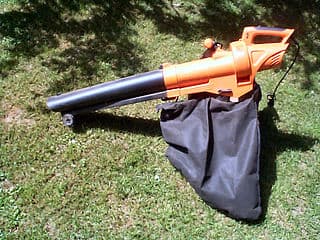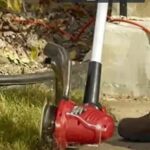As an Amazon Associate, this site earns commissions from qualifying purchases. For more information click here.
Gas leaf blowers come in all shapes and sizes, but the one thing they share in common is the need for proper fuel. This means you have to get the gas and oil mix ratio right. This seems like a trivial matter but your leaf blower will not run unless this is done correctly. This can cause serious engine problems, so this guide was created to help you.
Leaf blowers often use a 40:1 gas to oil mix ratio. This is equal to 3.2 ounces of oil per one gallon of gas. Most leaf blowers prefer regular unleaded, 87 octane or higher gas with 10% or less ethanol.
How to Mix Leaf Blower Gas and Oil
Before you start mixing fuel, the first thing you should do is consult your owner’s manual. If you no longer have it, look up your leaf blower make and model on the manufacturer website. There should be an online guide available.
There are three things you need to look for: what type of gas is needed, the octane rating and mix ratio. Depending on what leaf blower you have, mixing may not even be required. Four-stroke engines do not need any mixing to run a leaf blower, but for two-stroke engines it is. Once you are done with these preliminaries, you can proceed to the mix.
This video demonstrates the mixing process. If you want to get written instructions, keep reading.
Step 1. Read the manufacturer instructions on how much gas and oil are need. Buy the exact type required. If the instructions say use 40:1 ratio for instance, follow it.
Step 2. Take your leaf outdoors or someplace well-ventilated. Take all safety precautions necessary when you mix gas and oil.
Step 3. Mix the gas and oil. If the ratio is 40:1 and you bought a gallon of gas, add 3.2 ounces of oil into it. If you bought two or more gallons, pour only a gallon into a separate container and add the oil. Make sure you keep the ratio correct. Keep track of how much you are working with.
Step 4. Close the container when you are done pouring. Shake it a little to help with the mix.
Step 5. Pour the mixture into your leaf blower fuel tank. If the engine smokes when in use, you put too much oil in the mix. Just let the engine run so it can get rid of the excess fluid. If you get the ratio right the engine will run smoothly.
A couple of reminders: you must always use gas and oil. Running that 2-stroke engine on gas only will create all kinds of problems and may cause permanent damage.
Second, empty the fuel tank if you are not going to use the leaf blower for a long time. Prolonged storage without use causes the fuel to turn gummy, making it impossible to start the engine.
Popular Leaf Blower Gas Mix Ratios
Majority of leaf blower manufacturers recommend a 40:1 gas and oil mix ratio. The octane rating should be 87 and up and ethanol at 10% or less. Gas with 10% ethanol are labeled E10 while those with 15% ethanol are E15. If your leaf blower will not rev there is probably something wrong with mixture.
While 40:1 is the most common mixture ratio, other leaf blowers use 50:1 or 32:1. This is why it is necessary to check the manufacturer recommendations. Do not assume all two-stroke engines use 40:1 because they do not. Here are the gas mix ratios for some popular leaf blower manufacturers: Check your manufacturer for details if it is not on the table. As you can see, 40:1 is the most common though 50:1 is becoming more popular.
Table. Leaf blower fuel ratios
| Manufacturer | Fuel Mix Ratio | Notes |
|---|---|---|
| Craftsman two-stroke engine | 40:1 | Manufacturer recommends 3.2 ounces of oil per one US gallon of gas |
| Husqvarna two-stroke engine | 40:1 | 3.2 ounces of oil per one US gallon of gas |
| Craftsman two-stroke engine | 40:1 | Same as the Husqvarna 2-stroke |
| Craftsman two-stroke engine | 50:1 | 50:1 for their two-stroke engines, or 1/10th liter of oil per 5 liters of gas. Only premium unleaded gasoline should be used. If you have a Makita four-stroke engine, only premium unleaded gas is needed. |
| Poulan Pro two-stroke engine | 40:1 | 87 or higher octane rating ideal |
| Ryobi two-stroke engine | 50:1 | 50:1 or 2.6 ounces of oil per gallon of regular unleaded gas. Their older models use a 32:1 ratio and have been superseded by the newer ones that all use 50:1. |
| Troy Bilt two-stroke engine | 40:1 | 40:1 ratio for all two-stroke engines released in 2003 and later. Models from 2002 and earlier use a 32: 1 ratio. |
Gas Mix Ratio in Gallons and Liters
Some brands use gallons while others print their instructions in liters. Here is a comparison of the two. Note that this is an approximation only as gallons and liters cannot be converted exactly.
The most common gas container size is 1 gallon, but 2, 2.5 and 5 gallons are available. For liters you will find 5, 10 and 20.
This is for general information only. You should consult your manual or contact the manufacturer for more details.
| Gas and Oil Ratio | Ounces of Oil Per Gallon of Gas | Milliliters of Oil Per 5 Liters of Gas (approx. 1 1/4 gallon) |
|---|---|---|
| 20:1 | 6.4 ounces | 250 ml |
| 30:1 | 4.3 ounces | 167 ml |
| 32:1 | 4.0 ounces | 156 ml |
| 40:1 | 3.2 ounces | 125 ml |
| 45:1 | 2.8 ounces | 111 ml |
| 50:1 | 2.6 ounces | 100 ml |
| 60:1 | 2.1 ounces | 83 ml |
| 80:1 | 1.6 ounces | 63 ml |
Whatever the mix ratio is, the important thing is that you prepare the mix. If you do not there is a good chance your leaf blower will malfunction. That is why manufacturers provide instructions on what mix ratios to use and how to go about it.
Mistakes to Avoid When Mixing Gas and Oil
Use only fresh oil and gas. Never use old stock as it could cause problems later on. When mixing, focus on getting the ratio correct. Use a measuring container to avoid mistakes.
Some manufacturers recommend specific brands of gas and oil. Use them whenever possible as they are optimized for that leaf blower. Using another brand will not necessarily harm your equipment, but it may not produce the best results.
If you pour too much oil, add a little more gas. It will not hurt the mixture. Try to get this right because if you always add too much oil, it will damage the spark plug and cause performance problems.

If you added too much gas the engine might not start. Worse it can damage other parts of your leaf blower. Even if the motor escapes damage, it will be prone to wear and tear.
While most brands suggest regular unleaded gas, premium unleaded is not going to cause any problems. Unless the manufacturer specifically states you cannot use premium gas, there should be no issues.
If you mixed the fuel properly but the engine won’t start, do an Ignition coil test to see if there is something wrong. If the gas mix ratio is right but the leaf blower refuses to start, there is an issue with the motor or other parts.
Do Four-Stroke Engines Need a Gas Mix?
Short answer is no, they do not. If your leaf blower uses a four-stroke engine, just use high quality gas and you are set. No need to do any mixing as it is not required.
Two-stroke engines cannot run unless you mix gas and oil properly. There are premixed gas available, but while convenient can be expensive in the long run. If your leaf blower is used often, buying premixed gas will add up, cost wise. And mixing gas and oil is easy enough as the instructions here have shown.
Most leaf blowers use two-stroke engines because it costs less to make. Yes a two-stroke engine is noisier and less efficient, but it is lighter and less complex. While four-stroke engines are becoming common, two-stroke versions will be here a while.

I love the outdoors and all the tools for maintaining gardens, yards and lawns. The only thing I am more passionate about is sharing what I know about garden and outdoor equipment.


